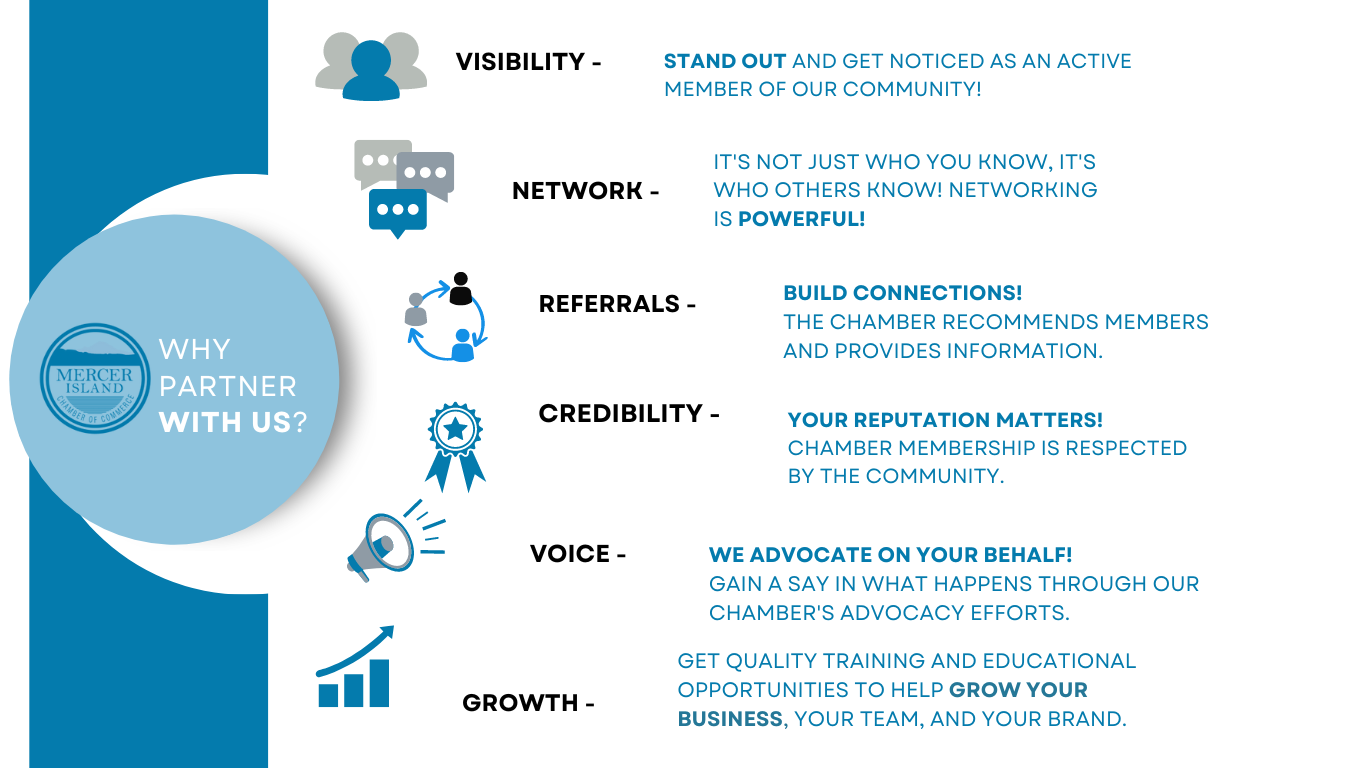マーサーアイランドへの玄関
1946 年に設立されたマーサー アイランド商工会議所は、会員の支援とプロモーション、教育リソース、ネットワーキングの機会を提供してきた長い歴史を持っています。
マーサーアイランドの企業向け
多様な企業を代表する当協会は、地域社会や地方自治体と連携して会員の発展、成長、繁栄を支援しています。ビジネス教育、ネットワーキング、地域イベント、支援、代表活動を通じて、マーサーアイランド商工会議所は各会員の成長と繁栄を支援することに尽力しています。
「当社で働くことで、大きな成長のチャンスが生まれます」
最新メンバー
最新のビジネスブログ投稿

As we enter this beautiful holiday season, I want to share something close to my heart: the power of genuine connection and community building for our small businesses. After more than a decade of networking and bringing business owners together, I've seen firsthand how the relationships we build during the holidays can transform our businesses and our lives. This isn't just about exchanging business cards, it's about creating a supportive community where we all thrive together. Why Holiday Networking Matters for Our Community The holidays offer something special: people are more open, more generous, and more willing to connect authentically. When we come together during this season, we're not just building business relationships, we're strengthening the fabric of our entire business community. We Lift Each Other Up Small business ownership comes with unique challenges. When we network, we create a circle of fellow entrepreneurs who truly understand the journey. These connections become our cheerleaders, our advisors, and our friends. Together, we're stronger. We Expand Our Reach Every conversation is an opportunity to share your story and discover new possibilities. When you authentically connect with others, they become ambassadors for your business, naturally sharing about you with their own networks. This organic growth is powerful and sustainable. We Learn From Each Other Our community is full of wisdom and experience. Through networking, we share insights, strategies, and lessons learned. This collective knowledge helps all of us become better business owners and community leaders. We Create Collaborative Opportunities Some of the most exciting business growth happens when small businesses collaborate. Through meaningful networking, you'll discover partners whose strengths complement yours, opening doors to joint ventures, cross-promotions, and shared success. Simple Ways to Network This Holiday Season You don't need a complicated strategy or perfect pitch. Here's how to connect authentically this season: Join Community Events Look for holiday gatherings, Chamber events, local fundraisers, or business mixers. Come as yourself, with an open heart and genuine curiosity about others. The best connections happen when we're authentic. Reach Out With Gratitude Send personalized holiday messages to your business connections. Share your appreciation for their support and friendship this year. These thoughtful gestures strengthen bonds and keep relationships warm. Create Connection Spaces Consider hosting a casual gathering, a coffee meet-up, a virtual celebration, or a holiday open house. When you create spaces for others to connect, you become a community builder, and that's invaluable. Give Back Together Partner with fellow business owners to volunteer during the holidays. Serving your community together builds deep, meaningful connections while making a positive impact. Always Follow Through After meeting someone new, reach out within a few days. Share that resource you mentioned, make that introduction you promised, or simply say how much you enjoyed meeting them. Reliability builds trust. Lead With Generosity Here's what I've learned at The Networking Bee Group: the strongest networks are built on generosity, not transactions. When you focus on how you can support others, help them succeed, and contribute to the community, everything changes. People remember your kindness. They trust you. They want to collaborate with you and refer others to you. This community-first approach isn't just good for business, it's good for the soul. Your Holiday Networking Action Plan I invite you to commit to three simple actions this season: 1. Attend at least one Chamber or community networking event. 2. Send personalized thank-you messages to five business connections expressing genuine appreciation. 3. Connect two people in your network who could benefit from knowing each other. These small, intentional steps create ripples of connection throughout our entire business community. Let's Grow Together At Seattle Agenda and The Networking Bee Group, our mission is simple: to help small businesses build authentic connections that lead to real growth. This holiday season, I encourage you to embrace networking not as a business task, but as an opportunity to build the collaborative, supportive community we all deserve. When small businesses work together and lift each other up, our entire community flourishes. Let's make this holiday season the beginning of meaningful connections that carry us into a prosperous new year. Here's to community, collaboration, and connection. Lynette VGarcia Blanks

We’re fast approaching the time of year where it can like you’re running a marathon on a tightrope. Customers need attention. Promotions are queued up to be launched (or designed). Your inventory is giving you nightmares and you have huge goals for the end of the year. And you’re supposed to stay cheerful, strategic, and somehow well-rested through it all. But the problem isn’t your big aspirations for 2026, nor does the problem lie in trying to solve the things you can’t control. It’s your habits. James Clear’s Atomic Habits reminds us that meaningful results come from the small, repeatable choices we make every day. During the holidays, those tiny decisions are the difference between burnout and breakthrough. When you build systems that work even when you’re tired, distracted, or knee-deep in ribbon, the season gets lighter and your business gets stronger. Here’s how to apply some of Clear’s most practical ideas to help you not just survive the holiday season, but launch into January with invincible momentum. Start with a 1% Mindset One percent doesn’t sound like much until you stack it day after day. You don’t have to reinvent your business. You don’t need a perfect storefront, flawless offers, or an Instagram grid that looks like a lifestyle magazine. Instead, choose one area to improve just slightly. Take that one small step toward your goal. · Maybe it’s tightening up your email promo schedule. · Maybe it’s creating a smoother checkout flow. · Maybe it’s something as simple as promising yourself (and following through on) a good night’s rest for the next month. Small refinements reduce stress and increase sales. They also remind you that progress is happening, even in chaos. Re-design Your Environment Clear says our surroundings often shape our behavior more than our motivation does. This is especially true during the holidays when the pace is high and attention is scattered. Look around your space with strategic eyes. If your workspace feels cluttered, simplify it. If your best seasonal products aren’t visible at first glance, elevate them. If your team keeps losing pens, square readers, bags, or bows, create a “holiday command center” with everything in one place. Tiny environmental shifts create smoother systems. And smoother systems prevent those frantic moments when you’re internally screaming, “Where did we put the gift bags?!” Build Habits That Support Your Busiest Days The season is unpredictable, so anchor your day with predictable habits. A few anchors to consider: • A 5-minute morning reset, before opening or seeing clients • A quick end-of-day review: what sold, what slowed down, what needs restocking, what got clicks, what impact on our customers did we see? • A customer-touch habit: one message, one email, or one thank-you note daily • A “two-minute tidy” before leaving (your future self will adore you) Consistency creates stability. When everything else feels like holiday improv, these anchors act like rhythm lines on the page. Use Systems, not Willpower If you remember nothing else from this article…pay attention… Willpower gets weaker when you get tired. Systems don’t. If you want to post consistently on social media, schedule a week’s worth of content on one calmer afternoon. If you want to upsell a holiday special, script one clear line for every team member. If you want to stay on top of inventory, set an alarm that reminds you to check key items before the weekend rush. During the holidays, systems carry you when energy can’t. Make Good Habits Easy and Bad Habits Harder Clear’s “make it obvious, make it attractive, make it easy, make it satisfying” formula is your season’s secret weapon. Want your team to use the upsell script? Keep it taped near the register or near each desk. Want customers to sign up for your loyalty program? Put the QR code where people naturally pause and that can be more than one spot. Want to stop scrolling between transactions? Keep your phone in a drawer. Design beats discipline every time. Don’t Forget Identity: Who Are You Becoming This Season? In Atomic Habits, Clear says outcomes come from identity. While you’re navigating the busiest weeks of the year, take a breath and remember who you are as a leader. · Are you the business that handles crowds with warmth? · The business that makes people feel good? · The business that takes care of its team so they can take care of customers? When you anchor yourself in identity, your choices shift. You show up differently. You communicate more intentionally. You prioritize what matters instead of chasing every glitter-coated opportunity. And your customers feel it. Give Yourself Permission to Rest This sounds counterintuitive in a season that thrives on hustle, but rest is productivity’s partner. Clear reminds us that habits compound. That includes bad ones like exhaustion, resentment, and skipping meals. Take care of yourself the way you take care of your customers. Breaks aren’t indulgent; they’re fuel. Let the Season Shape You—Without Steamrolling You You don’t need massive change. You need micro-moves that create calm, clarity, and steady revenue. If you build the right habits now, January stops being a “recovery month” and becomes a runway. Your systems will be tighter. Your team will be stronger. And you’ll have proof that even small businesses can thrive in big seasons.

With the holiday season approaching with the speed of a bullet train (holiday prep, year-end sales pushes, family gatherings, budget reviews, etc.), it’s no surprise many of us feel our blood pressure and tension rise, while our patience comes crashing down. While this season is one of the most exciting of the year, it brings lots of extra stress. But what if some of that stress was unavoidable? Maybe we can’t keep that troublesome relative away but we can borrow wisdom from the minimalist movement and writer Joshua Becker’s article, “The Stress We Needlessly Bring into Our Lives.” Here are four practical reframes you can share with your team and apply to your own workflow, designed specifically for business juggling multiple moving parts in busy months ahead. 1. Stop Comparing—Start Aligning It’s tempting to look at other businesses and feel like you’re falling behind. Maybe their social media looks polished, their storefront’s decorated like a movie set, or their sales numbers seem untouchable. But comparison steals focus. Your business has its own rhythm, audience, and goals. Instead of chasing what others are doing, take stock of what’s working for you. Consistency and authenticity will always outlast temporary trends. 2. Simplify Your Season Overcommitment is one of the biggest stress traps. For business owners, that often means piling on extra promotions, extending hours you can’t sustain, or saying yes to every collaboration that comes along. You might be busy and pulled in many directions but it’s unlikely you’ll feel accomplished if you overcommit yourself to trying to do it all at the same time. Imagine if you wanted to paint your entire house. If every day you woke up and painted a different area for one hour, it would be a very long time before the house would feel complete. At the end of a month, you will have put in 30 or so hours in painting but you may not even have an entire room finished. You’ll feel depleted and dissatisfied even though you spent a month working on it. This year, try doing fewer things better. Focus your efforts on what brings in customers or builds lasting relationships. Simplifying isn’t a step back; it’s a strategy for quality and control and doing more of what works, not more of a little bit of everything. 3. Build Breathing Room Into Your Calendar Every business has busy seasons, but nonstop hustle doesn’t equal progress. Schedule short breaks or “quiet hours” each week to regroup, brainstorm, or catch up. You’ll make better decisions when you’re not rushing from one task to the next. Encourage your employees to do the same. A calm, focused team provides better service and represents your business more positively, especially during the holidays, when stress levels tend to spill over. 4. Reevaluate Expectations The pressure to please customers, employees, and family can quickly become overwhelming. But not every long-standing tradition or offer is worth the toll it takes. If a particular sale or event no longer delivers value, it’s okay to let it go or reinvent it. Communicate changes early and clearly, and most customers will understand. When expectations are realistic, everyone wins. 5. Redefine Success for the Season This time of year, we tend to measure success by numbers—sales totals, event attendance, new clients. But remember, success also looks like closing the year without burnout, keeping your team motivated, or maintaining great customer experiences through the chaos. As Becker notes, “We can’t control everything. We can only control our choices.” Choose the ones that keep you steady, clear-minded, and ready for what’s next. Running a business is demanding, and the holidays only amplify that reality. As your Chamber, we encourage you to slow down where you can, focus on what truly matters, and give yourself credit for how far you’ve come. You’ve built something worth protecting—your time, your team, and your wellbeing included. As we move into the holiday season, we’re here to support your continued success, one thoughtful choice at a time. Let us know how we can help.
今すぐ参加しましょう!
あなたのビジネスアドボケート、プロフェッショナルリソースセンター、コミュニティコネクター、ネットワークビルダー!
私たちと連絡を取り合いましょう
インスタグラム!
Member Feature
Meet Jason and Robin Farrish, owners of The Crawlspace Gastropub! They opened this last summer on Mercer Island and their menu is centered around Korean fusion cuisine! They have everything from Korean BBQ to burgers, booze, wings, tacos, and steak. Everything is uniquely hand crafted with Korean, Hawaiian, Mexican, and Latin American influences!
Visit the chamber member directory on the website to learn more about The Crawlspace Gastropub and their incredible menu!
#mercerisland #mercerislandchamber #chamber #smallbusiness #localbusiness # business #food #koreanfusion #fusioncuisine #restaurant
CLOSED
🥳 HAPPY BIRTHDAY CHAMBER CEO JEN DEAN!
‼️ GIVEAWAY ‼️
Jen, is a Midwest native with roots in Michigan, where she grew up raising beef cattle. Those early mornings and hard work taught her the value of dedication and the secret to a truly great burger. She’s always on the lookout for restaurants that get burgers just right.
But Jen’s culinary adventures don’t stop there. She enjoys a fancy night out just as much as a casual burger joint. For her, it’s all about experiencing the artistry of food and the stories behind the menus.
We are giving away a $25 gift card to The Crawlspace Gastropub-because they do burgers right and $25 gift card to Allister -because they do fancy right!
To Enter:
1. Like this post
2. Tag your favorite culinary buddy
*make sure you are following the chamber page
Contest ends at today 7:00pm
Join us from 4:00:500pm at The Crawlspace Gastropub for happy hour birthday celebration!
#mercerisland #mercerislandchamber #celebrate
CLOSED
‼️GIVEAWAY‼️
We continue the countdown to CEO Jen’s birthday on day 3 of giveaways with a little dig into the archives of her heritage.
Jen’s father was adopted from Italy (many years ago😉) gifting her a rich blend of Italian and Mediterranean heritage. Her love for food reflects this heritage, with favorites like hummus, Greek salad, chicken kabobs, and hearty pasta dishes.
Jen’s love for a wide variety of music and her musical talents also stem from her father. Fun fact: Jen is a former cornet player! 🎺
To honor her Italian/Mediterranean and musical heritage we’re giving away a $25 gift card to Volver Records and a $25 gift card to Pogacha.
To enter:
1. Like this post
2. Tag your favorite person to share an evening of dinner and music with
*Make sure you are following the chamber page
Giveaway closes at 7pm today (October 30th)
And mark your calendars for birthday happy hour at The Crawlspace Gastropub on Thursday, October 31st from 4:00-5:00pm.
#mercerisland #mercerislandchamber #burthday #italy #mediterranean #music #heritage #celebrate #family
We heard you loud and clear. You LOVE the 5 Chambers Networking events, but 7:30am is a little too early for some. Well, here is an event especially for you!
5 Chambers After Hours
Thursday, November 7th
4:00-6:00pm
Remlinger Farms
Join Mercer Island Chamber, Newcastle Chamber, Issaquah Chamber, Sno Valley Chamber, and Sammamish Chamber for a special after-hours event. Grow your professional and personal network while enjoying the grounds at Remlinger Farms.
Non-alcoholic drinks and appetizers included in ticket price.
Alcohol available for purchase.
Click the link in our bio to register today.
Members and guest welcome!
#mercerisland #mercerislandchamber #chamber #afterhours #networking #growyournetwork
‼️ GIVEAWAY DAY 2 ‼️
CLOSED
We continue our 4 days of giveaways to celebrate chamber CEO Jen Dean's birthday with books and coffee!
Jen is a coffee lover, maybe even a snob. Jen believes that Washington has some of the best coffee shops in the country! One of her favorite brands is Tony's Coffee which happens to be a native roaster out of Bellingham, WA.
Jen is also loves to journal. Give her a cup of coffee, a beautiful view and a journal and she is set for hours.
To celebrate, we are giving away a bag of Tony's coffee, a coffee mug, and a $25 gift card to Island Books ( @island.books )so you too can pick up a journal.
To enter:
1. Like this post
2. Tag your favorite person to grab coffee with
*make sure you are following the chamber Instagram page
Contest closes at 7pm today (October 29th)
And mark your calendars for birthday happy hour at The Crawlspace Gastropub on Thursday, October 31st from 4:00-5:00pm
#mercerisland #mercerislandchamber #celebrate #coffeelover #books #journal #birthday #shoplocal
CLOSED
‼️ GIVEAWAY TIME ‼️
It's chamber CEO Jen Dean's birthday week, and to celebrate we are doing a giveaway for the next 4 days of some of her favorite local items all while getting to know a little more about her.
So let's kick off day 1!
Jen loves flowers. Fresh flowers. If she could, she would have fresh flowers delivered every week for every room in her home. Her favorite flower, gladiolus, and a close second would be dahlias.
Also, when it comes to sweets Jen is a chocolate fan, dark chocolate to be exact. You can keep the skittles, vanilla cake, and gum drops, she will take chocolate every time.
To celebrate we are giving away a $25 gift card to Mercer Island Florist and truffles from Oh Chocolate.
To enter:
1. Like this post
2. Tag the person who loves flowers too
*make sure you are following the chamber Instagram page
💐🌺🌷🌹🍫🧁🎂
Contest ends at 7pm today (October 28th)
🥳 And mark your calendars for birthday happy hour at The Crawlspace Gastropub for Thursday, October 31st from 4:00-5:00pm.🥂
#mercerisland #mercerislandchamber #birthday #flowerlover #chocolatelover #celebrate
City of Mercer Island, Mercer Island Chamber, and Bloodworks Northwest are teaming up again for an end of year blood drive.
Monday, November 4th
10:30am-4:30pm
MI Community & Event Center
Did you know 63% of Americans are eligible to donate, yet only 3% actually donate? Let's get that 3% up! Our last blood drive on Mercer Island back in August saw 7 new first-time donors. Great job Mercer Island community.
Click the link in our bio to schedule your appointment.
#mercerisland #mercerislandchamber #community #blooddrive #donateblood
One week away from THANKFUL FOR LOCAL BINGO begining November 1st!
All month long in November we are elevating our local businesses with a fun game of BINGO.
Starting November 1st, you can pick up a card at participating locations, complete the task on the card, complete a BINGO, and turn your card in at the chamber office to be entered to win a grand prize-Mercer Island Gift Card Frenzy-valued at $450+.
It is a great way to explore town center, get to know your neighbors who run these businesses, and have family fun.
*See card for official rules*
#thankful #local #supportlocal #mercerisland #mercerislandchamber #bingo #communityfun
Over on the chamber blog,
Why Agility is One of the Most Important Things in Your Marketing
The market is volatile. No, we’re not talking about stocks. The needs and desires of your audience are evolving, and your business marketing needs to follow suit. If you’re not practicing agile marketing, you’re going to fall behind.
Agile marketing is one of the most crucial aspects of marketing for businesses today. It offers significant advantages in an ever-changing marketplace. And the public’s expectations surrounding it (bet you didn’t know they already expect agility in marketing) can mean a potentially costly mistake for businesses that aren’t implementing it.
What Is Agile Marketing?
Agile marketing is the practice that allows marketers to adapt to changing environments, whether that be social media trends, customers’ needs/desires, or responses using emerging technologies. When you are an agile marketing shop, you can make changes to your current campaigns quickly for the benefit of your customers and ideal audience.
Click the link in our bio to continue reading over on the chamber website.
#mercerisland #mercerislandchamber #chamberblog #businesstips #marketing #blogpost
We heard you loud and clear. You LOVE the 5 Chambers Networking events, but 7:30am is a little too early for some. Well, here is an event especially for you!
5 Chambers After Hours
Thursday, November 7th
4:00-6:00pm
Remlinger Farms
Join Mercer Island Chamber, Newcastle Chamber, Issaquah Chamber, Sno Valley Chamber, and Sammamish Chamber for a special after-hours event. Grow your professional and personal network while enjoying the grounds at Remlinger Farms.
Non-alcoholic drinks and appetizers included in ticket price.
Alcohol available for purchase.
Click the link in our bio to register today.
Members and guest welcome!
#mercerisland #mercerislandchamber #chamber #afterhours #networking #growyournetwork
City of Mercer Island, Mercer Island Chamber, and Bloodworks Northwest are teaming up again for an end of year blood drive.
Monday, November 4th
10:30am-4:30pm
MI Community & Event Center
Did you know 63% of Americans are eligible to donate, yet only 3% actually donate? Let's get that 3% up! Our last blood drive on Mercer Island back in August saw 7 new first-time donors. Great job Mercer Island community.
Click the link in our bio to schedule your appointment.
#mercerisland #mercerislandchamber #community #blooddrive #donateblood
Small businesses that are looking for financing through a business loan have several options, though they vary greatly depending on the scope of your business and its needs. Here are some common types of small business loans you can expect to find, and what to know before you choose a loan and apply.
#mercerisland #chamber #mercerislandchamber #smallbusiness #loans #finances #funding
Get ready for THANKFUL FOR LOCAL BINGO returning November 1st!
All month long in November we are elevating our local businesses with a fun game of BINGO.
Starting November 1st, you can pick up a card at participating locations, complete the task on the card, complete a BINGO, and turn your card in at the chamber office to be entered to win a grand prize-Mercer Island Gift Card Frenzy-valued at $450+.
It is a great way to explore town center, get to know your neighbors who run these businesses, and have family fun.
*See card for official rules*
#thankful #local #supportlocal #mercerisland #mercerislandchamber #bingo #communityfun
This week on the chamber blog,
How to Be More Engaging
If you want more views on your business content, you don’t have to be a celebrity (although that makes things a lot easier). All you have to do is help your audience get to know you, and by doing so, humanize your business.
Some people are gifted engagers. They naturally know how to get people interested in their stuff. But for most of us, it’s a learned activity. If you’re not a born engager, here are five things you can do to improve your business content.
5 Engaging Content Tips:
Click the link in our bio to continue reading over on the chamber website.
#mercerisland #mercerislandchamber #chamberblog #businessblogpost #businesstips #marketing
Member Feature
Three generations of the Krautheim family have been creating artisan chocolates in Seattle since 1985. Margo Masaoka now oversees the original flagship store on Mercer Island, working alongside her daughter and son-in-law, Marisa and Ty Barrett, both incredible chocolatiers!
Oh! Chocolate is proud of its history of producing hand-crafted chocolates in flavors and tastes that support both traditional as well as cutting-edge culinary flavors. They have a wide selection of chocolate treats and they also offer hands on chocolate classes!
Visit the chamber member directory on the website to learn more about Oh! Chocolate and their delicious treats.
#mercerisland #chamber #mercerislandchamber #shoplocal #smallbusiness #chocolate #treats #chocolateclasses #ohchocolate
Just one week away for our first Witches Night Out on Mercer Island.
Thursday, October 24th
6:30pm-9:00pm.
Grab your best witches custome, broomstick, and friends and stroll the streets of Mercer Island for this pub crawl type event.
Witching hour begins at 6:30pm with a photo op at Barrels Wine Bar. Enjoy some enchanting drinks, then grab a map and make your way to participating locations for spooky drink specials, treats, tarot card readings, and more.
Participating Locations:
The Crawlspace Gastropub
Barrels Wine Bar
Pogacha
Allister
Asa Gathering
Island Books
#mercerisland #mercerislandchamber #spookyfun #witchescrawl #halloweenfun #pubcrawl #halloweenevents
4 Days Away from Women's Day Out!
Sunday, October 20th
10am-2pm
Mercer Island Community and Event Center
Will you be there?
Workshops, classes, shopping, spa treatments, music, photo opps, giveaways and more.
Grab your friends and come out for that break in the business for some fun.
Click the link in our bio to learn more and grab tickets.
Last week!
2025 Chamber Vision Survey
We want to hear from YOU!
Whether you are a chamber member or not; own a business, or work for a local company; if you have vested interest about the business community on Mercer Island and beyond, we want to hear from you.
As we plan our 2025 programing, we want to make sure we are providing valuable resources and opportunities for you to grow your business and professional network.
Click the link in our bio to take the survey.
#mercerisland #mercerislandchamber #vision #strategy #businessgrowth #supportinglocal
Are you ready?!
Join us for the grand opening of Volver Records on Mercer Island.
Friday, October 18th at 10am.
Grab some friends and come check out Volver Records new space and extensive selection of vinyl records and more.
Volver Records
7785 Sunset Highway, Suite 249
Mercer Island, WA 98040
#mercerisland #mercerislandchamber #grandopening #ribboncutting #seattle #openingcelebration #recordstore
Have your registered? Don't miss our next Business Workshop: SEO 101: Get Ranked without the Headache
We wrap up our October series with your biggest business seller, your website. Jaclyn is an expert on SEO and she will break down the terminology and fundamental strategies so you can get your business SEEN by your audience. Let's grab those leads!
Click the link in our bio to register.
No cost to chamber members.
$10 for non members/guests
Registration required.
#mercerisland #mercerislandchamber #businesssupport #localbusiness #businesstips #workshops
‼️Exciting News‼️
Join us for the grand opening of Volver Records on Mercer Island.
Friday, October 18th at 10am.
Grab some friends and come check out Volver Records new space and extensive selection of vinyl records and more.
Volver Records
7785 Sunset Highway, Suite 249
Mercer Island, WA 98040
#mercerisland #mercerislandchamber #grandopening #ribboncutting #seattle #openingcelebration #recordstore
Growing a business email list requires a multi-faceted approach of conventional and innovative ways. Traditional techniques like website pop-ups, lead magnets, and social media promotions remain effective, while unique strategies such as interactive quizzes, and gamified loyalty programs can get you noticed. If you want to stand out, try a few of these options.
#mercerisland #mercerislandchamber #chamber #smallbusiness #email #subscribers # growth #local
Business Workshop: SEO 101: Get Ranked without the Headache
We wrap up our October series with your biggest business seller, your website. Jaclyn is an expert on SEO and she will break down the terminology and fundamental strategies so you can get your business SEEN by your audience. Let's grab those leads!
Click the link in our bio to register.
No cost to chamber members.
$10 for non members/guests
Registration required.
#mercerisland #mercerislandchamber #businesssupport #localbusiness #businesstips #workshops
Whether you are a retailer or an online business owner, the holidays can mean a spike in sales. Woohoo!
Many retailers see 20-30% of annual sales in November and December 🎉 For online business owners it can be up to 40% or more! It’s time for you to get your piece of the pie.
Join us for our next Business Workshop: Holiday Marketing Prep: Strategies for Small Businesses
Join us for a practical, no-nonsense workshop designed to help small business owners plan and execute holiday promotions—without the stress and last-minute panic. Whether it’s an e-mail campaign, collaboration, event, or social media promotion, the time to get started is now!
We will spend time mapping out your holiday promotional plan and collaborating with peers to get realtime feedback on your offers.
No cost for chamber members.
Non-members/guests $10
Space is limited.
Click the link in our bio to register.
#mercerisland #mercerislandchamber #businessworkshop #marketing #holidayseason #businessstrategy
2025 Chamber Vision Survey
We want to hear from YOU!
Whether you are a chamber member or not; own a business, or work for a local company; if you have vested interest about the business community on Mercer Island and beyond, we want to hear from you.
As we plan our 2025 programing, we want to make sure we are providing valuable resources and opportunities for you to grow your business and professional network.
Click the link in our bio to take the survey by October 11th.
#mercerisland #mercerislandchamber #vision #strategy #businessgrowth #supportinglocal
It's Friday and Mercer Island's restaurant scene is hot! 🔥
Whether you're looking for pizza, wings, steak, smash burger, or more our local restaurants have you covered!
And if you are looking for that exceptional craft cocktail, beer, or glass of wine to go with dinner there is no shortage of options there either.
Check out one of the new restaurants, Allister or Crawlspace Gastropub, or one of the island's corner stone restaurants, Pogacha or Mioposto. If you're looking for a night in then Sahara Pizza has you covered.
While you're at it make reservations for Saturday or Sunday BRUNCH! That's right Allister, Pogacha, Mioposto, and Crawlspace Gastropub (Sunday's only for now) serve brunch!
#shoplocal #dinelocal #mercerisland #mercerislandchamber #letseat #dinner #brunch #pizza #craftcocktails #burgers #wine #Korean #american #italian
Member Feature
Island Books is an independent bookstore that has been on Mercer Island. for over 45 years. On top of having a wide selection of books, they also sell cards, gifts, games, toys, and locally-made chocolates. They even wrap presents with a bow and ship them anywhere in the United States. Island Books also hosts a variety of events. From weekly morning storybook corners, monthly PJ story times, book fairs, monthly book clubs, to author events, and more. Most importantly, they develop close relationships with their customers to create a cozy and welcoming environment for people of all ages and interests!
Visit the chamber member directory on the website to learn more about Island Books and their services.
#mercerisland #chamber #mercerislandchamber #business #memberfeature #islandbooks #localbusiness #books #bookstore
Whether you are a retailer or an online business owner, the holidays can mean a spike in sales. Woohoo!
Many retailers see 20-30% of annual sales in November and December 🎉 For online business owners it can be up to 40% or more! It’s time for you to get your piece of the pie.
Join us for our next Business Workshop: Holiday Marketing Prep: Strategies for Small Businesses
Join us for a practical, no-nonsense workshop designed to help small business owners plan and execute holiday promotions—without the stress and last-minute panic. Whether it’s an e-mail campaign, collaboration, event, or social media promotion, the time to get started is now!
We will spend time mapping out your holiday promotional plan and collaborating with peers to get realtime feedback on your offers.
No cost for chamber members.
Non-members/guests $10
Space is limited.
Click the link in our bio to register.
#mercerisland #mercerislandchamber #businessworkshop #marketing #holidayseason #businessstrategy
2025 Chamber Vision Survey
We want to hear from YOU!
Whether you are a chamber member or not; own a business, or work for a local company; if you have vested interest about the business community on Mercer Island and beyond, we want to hear from you.
As we plan our 2025 programing, we want to make sure we are providing valuable resources and opportunities for you to grow your business and professional network.
Click the link in our bio to take the survey by October 11th.
#mercerisland #mercerislandchamber #vision #strategy #businessgrowth #supportinglocal
Supporting small businesses in your community has a greater impact for the community at large than just the businesses you support.
Why it matters
* When you buy local, significantly more of that money stays in the community.
*59.3% of local, independent makers say they occasionally or usually use recycled materials, and 7% say they always use these materials.
*Local businesses give a community its flavor.
"Choosing to support an independent business is an act of respect; it’s acknowledging the tremendous risk and challenges inherent to starting your own thing.”
-Matt Kliegman (co-founder - The Smile, The Smile To Go, Black Seed Bagels)
#supportlocal #shoplocal #mercerisland #mercerislandchamber #bettercommunity #local #uniquecommunity #together #seattlelocal #quotes
At the most basic level, the goal is to get people on your email list who want to stay in contact with you. From a business perspective, most people join an email list because they are hoping for discounts or special deals. These methods, offer tried and true ways to get more subscribers.
title page: Methods to grow your business email list.
#mercerisland #chamber #mercerislandchamber #smallbusiness #business #local #email #businessemail #growth
Looking Ahead
We have curated a stellar line up to get your business ready for Q4. You don't want to miss these workshops.
Wednesday, October 2nd
Social Media Video Domination: Techniques for Business Growth
Michael with Praised Media is bringing years of expertise on techniques for growing your business with social media. If your social media, especially videos, are done in house you do not want to miss this class.
Wednesday, October 9th
Holiday Marketing Prep: Strategies for Small Business
Holidays are coming up fast and making sure your marketing game is on point to secure the most out of the year end, can feel overwhelming. Well, we are bringing in Claire Raphael with Claire Raphael Consulting to help you strategize your game plan, so you do not have to do it alone.
Wednesday, October 16th
SEO 101: Get Ranked without the Headache
We wrap up our October series with your biggest business seller, your website. Jaclyn is an expert on SEO and she will break down the terminology and fundamental strategies so you can get your business SEEN by your audience. Let's grab those leads!
You don't want to miss these workshops.
Click the link in our bio to get registered.
No cost to Chamber members
$10-$15 for guests
Space is limited.
#mercerisland #mercerislandchamber #businessgrowth #smallbusinesssupport #growtogether #seattlebusinesses #workshops
Last Chance! Don't miss our next After Hours event and a chance to meet Aegis Living- Mercer Island's new Marketing Director.
Whether you're looking to grow your network for referrals, peer connections, or a fun outing with other businesses professionals, the Business After Hours is that connection piece for just that!
Join us Thursday, September 26th from 5:00pm-6:30pm at Aegis Living-Mercer Island for drinks and lite bites.
After Hours is free and open to both members and guests, but with limited space so make sure you register.
Click the link in our bio to register today.
#mercerisland #mercerislandchamber #networking #businessgrowth #referrals #growyournetwork #connections
This week on the Chamber Blog:
10 Unique Ways to Get More Email Subscribers (plus 19 tried and true methods)
If you’re like most businesspeople, finding ways to get names on your emailing list can be exhausting. We all want tons of fans and followers. There’s value behind a list of people who are interested in what you offer. Most businesses start their list with people they know. But if you want to turn your email list into marketing gold, you need to get strangers (who will become potential customers) interested in you. That’s no easy task.
It’s the kind of activity that most of us avoid because the thought of it seems so overwhelming.
The Basics of Building an Email List
At the most basic level, your goal is to get people on your email list who want to stay in contact with you. From a business perspective, most people join an email list because they are hoping for discounts or special deals.
Here's a list of conventional methods to grow your business email list:
Click the link in our bio to continue reading!
#mercerisland #mercerislandchamber #blogpost #businesstips #emailmarketing #growth #customers
Social Media Video Domination: Techniques for Business Growth
It's 2024 and it's as crucial as ever for your business to standout online! Dive into the latest trends, strategies, and tools to elevate your brand's presence. Learn to craft compelling content that captivates audiences and drives results. From storytelling to optimization techniques, we'll cover it all. Led by Praised Media CEO Michael Hudson and his team - they will lead an immersive experience designed to supercharge your social media game!. Reserve your spot now and take your business to new heights through the magic of video!
Every attendee will receive:
- FREE resources and templates to use to elevate your video content for your business
- One (1) fully filmed and edited video by Praised Media to post on your Social Media channel(s)
Michael is a seasoned veteran in the world of video media, with over a decade of experience in the industry. Beginning his journey as an actor in Hollywood, he quickly made a name for himself and was a part of numerous productions. However, he wasn’t content with just being in front of the camera. He wanted to make an impact behind the scenes as well. And so, he made a successful transition into the business and marketing worlds. Today, he’s the driving force behind Praised Media, where he’s on a mission to elevate Business Brands with his expertise in video. He relishes working with diverse Business Owners and their Marketing Teams across the country, empowering them to achieve their goals and boost their leads and revenue.
www.praisedmedia.com
No cost to chamber members
Non-members/guests $15
Payment must be made prior to attending the class.
Space is limited.
Click the link in our bio to register.
#mercerislandchamber #mercerisland #socialmedia #growth #smallbusiness #supportlocal #businessworkshops #growyourbusiness
Whether you're looking to grow your network for referrals, peer connections, or a fun outing with other businesses professionals, the Business After Hours is that connection piece for just that!
Join us Thursday, September 26th from 5:00pm-6:30pm at Aegis Living-Mercer Island for drinks and lite bites.
After Hours is free and open to both members and guests, but with limited space so make sure you register.
Click the link in our bio to register today.
#mercerisland #mercerislandchamber #networking #businessgrowth #referrals #growyournetwork #connections
👋 Hello there!
We have a lot of new faces around here so we wanted to take a moment to introduce ourselves and let you know what to expect from us, your Mercer Island Chamber.
If I had a dollar for every person who said "what is a chamber of commerce", well I would retire! In all fairness chamber of commerce's were famous back in our grandparent's day. If you needed a reputable business you called, went online, or found the chamber directory, and that still rings true today. If you were visiting a town or wanted to know the best restaurants, you often visited or called the local chamber. Chambers have played many roles throughout the years in different communities, but still true today; Chambers are made up of businesses, industries, organizations, and professionals who believe in bettering the local economic, civic, and cultural climate in a community. That is what Mercer Island Chamber is.
We accomplish that with events, member meetings, networking opportunities, advocating for businesses at the city and state level, and much more.
And while you may not be here because you are a business owner or work in a business on Mercer Island, you are probably here because you want to know what is happening around Mercer Island and beyond in the business world. Whether new openings, fun events, or great sales, we also strive to make sure you know what local businesses are up to.
We are glad you are here, and can't wait to know you better.
~Jen, CEO
Leave us a wave in comments 👋👋
#mercerisland #mercerislandchamber #seattle #eastside #business #supportlocal #shoplocal #businessgrowth #latestupdates #businessupport #community
Women's Day Out
Sunday, October 20th
10am-2pm
Mercer Island Community Center
Fitness, Wellness, Shopping, Self-Care, Treats, Photo Fun, Classes, and more!
Join us for all things fun and YOU!
From health and fitness, to home goods, clothing, to service business that focus on women. We have curated a one stop shop.
So grab your friends and make it a girls day out.
While the day is geared toward women, ALL are welcome! Grab the partner, kids, any of your friends, just come have fun.
Swipe to the end for a special discount code.
#mercerisland #mercerislandchamber #health #wellness #financialwellness #women #female #communityevent #together
Member Feature
Gallagher Co. Construction has been building and remodeling homes on Mercer Island and neighboring communities since 2005. They have a depth of experience not only in residential, but in complex commercial construction projects.
Meet Tom Gallagher. He began his construction career 32 years ago and is now the owner & project manager. He has worked on many types of projects including; hotels, office buildings, high rise residential, single family residential, parking structures, industrial and high-tech facilities.
Visit the chamber member directory on the website to learn more about Gallagher Co. Construction and their services.
#mercerisland #chamber #mercerislandchamber #business #construction #building #remodeling
Whether you're looking to grow your network for referrals, peer connections, or a fun outing with other businesses professionals, the Business After Hours is the connection piece for just that!
Join us Thursday, September 26th from 5:00pm-6:30pm at Aegis Living-Mercer Island for drinks and lite bites.
After Hours is free and open to both members and guests, but with limited space so make sure you register.
Click the link in our bio to register today.
#mercerisland #mercerislandchamber #networking #businessgrowth #referrals #growyournetwork #connections
You don't want to miss our fall lineup of Business Workshops!
We kick off the series this week with Erin from Upkeeping as we host our next Business Workshop: Financial Cents-Getting the Most Out of Your Bookkeeping.
Are you a small business owner who also handles your own bookkeeping? Or maybe an entrepreneur who handles your own accounting. We have a workshop for you.
Join us this Wednesday, September 18th.
Workshop participants will be given practical tips on how to properly track financial performance, stay in compliance, and ensure long-term business success.
Participants will also have time to ask questions from an expert about their specific business.
Wednesday, September 18th
6-7:30pm
No cost to members
$10 for guests
Registration required
Click the link in our bio to register.
#mercerisland #mercerislandchamber #businesstips #workshops #financialtips #smallbusiness
Did you catch the latest on the Chamber blog?
Strategies to Identify and Reach Your Target Customers
"Social media is becoming more and more frustrating, right? If you have used it to connect with your audience for ten years or so, you undoubtedly have seen crazy changes in your reach. If you’re new to the social media for business scene, reaching 2% of your audience probably feels pretty normal.
But if you’re not reaching your audience, how are they going to know who you are and all the wonderful things your business can bring them?
When it comes to building a loyal following, there are several things you can do. Ultimately, reach is still dependent on the platform’s algorithm, but every social media channel claims to respond to value. To reach more people, you need them to see you as providing valuable content they want to interact with. Here’s how you can start doing that."
Click the link in our bio to continue reading.
#mercerisland #mercerislandchamber #blog #smallbusiness #strategies #customers #boostbusiness #business
If you don’t file your business taxes on time and become delinquent, you may face fines, penalties, and back taxes, so it’s important to know when they are due. Here are some of the most important business tax due dates for the remainder of the year:
#mercerisland #mercerislandchamber #chamber #taxes #endoftheyear #finance #business #local
We can’t believe it has been almost week since Art Uncorked. 🍷🎨
It was a beautiful day with an amazing selection of wines, art, food and music. 🌮🍤🍷🎨
And that photo backdrop of balloons made to look like a vine! 😱😍
We had so much fun and hope you did too.
What was your favorite part?
📸: @harringtonvisuals
#mercerisland #mercerislandchamber #letsparty #community #art #wine #events
Today is the National Day of Encouragement!
“Just one small positive thought in the morning can change your whole day.” —Dalai Lama
Start your day off with a positive mindset and encourage others to do the same! Give someone a compliment, spread positivity to those around you. Remind yourself that you are doing great!
#mercerisland #chamber #mercerislandchamber #national #encouragement #encourage #motivation
Just in time before the holidays, a financial check up workshop for your business.
Join us Wednesday, September 18th with Erin from Upkeeping as we host our next Business Workshop: Financial Cents-Getting the Most Out of Your Bookkeeping.
Workshop participants will be given practical tips on how to properly track financial performance, stay in compliance, and ensure long-term business success.
Participants will also have time to ask questions from an expert about their specific business.
Wednesday, September 18th
6-7:30pm
No cost to members
$10 for guests
Registration required
Click the link in our bio to register.
#mercerisland #mercerislandchamber #businesstips #workshops #financialtips #smallbusiness
Last call for registration!
Join us for our next Coffee & Conversations event with guests Sound Transit.
Hear from representatives on updates with light rail, as well as other projects Sound Transit has going on in the area.
These events aim to connect local and regional leaders with business leaders and provide an environment for meaningful conversations around topics of concern for the Mercer Island business community.
Sound Transit Representatives
Wednesday, September 11th
10:00am-11:00am
Mercer Island Community & Events Center
Click the link in our bio to register.
Registration is required as space is limited.
Coffee and snacks provided.
#mercerisland #mercerislandchamber #communitytalks #soundtransit #conversations #smallbusiness
Last day to get your Art Uncorked tickets before prices increase at midnight!
Art, wine, food, music, and fun, what more could you ask for!
📅Saturday, September 7th
⏲️3:00pm-7:00pm
🎟️$35 Advanced/ $10 Art Patron Ticket (no tasting tickets with this option)
🍷22+ wineries/brewery
🧑🎨14+ artisans
🍲food trucks
🎯games
🎶music
📸photobooth
and more!
Prices increase the day of the event.
Click the link in our bio to get yours.
#mercerisland #mercerislandchamber #chamberevent #communityevent #wine #winelovers #art #music
#chardonnay #whitewine #winetime #winery
#gallery #friends
Last day to register!
Lightning-fast networking with 100 attendees from 5 chambers, how else would you want to spend a Friday morning!
Join us for the 5 Chamber Networking Breakfast on Friday, September 13th at Hilton Garden Inn Issaquah from 7:30am-9:00am.
Enjoy a delicious breakfast while you grow your professional network.
$40 member rate
$55 non-member rate
Click the link in our bio to register.
#mercerisland #mercerislandchamber #networking #eastsidenetworking #chambers #businessgrowth #growyournetwork
Member Feature
JayMarc Homes was formed in 2010 by life-long friends and business partners of nearly 30 years, Jay Mezistrano and Marc Rousso. Based in Mercer Island, Washington, JayMarc Homes is a boutique building firm that builds luxury presale, move-in ready and custom homes in the Greater Seattle, Mercer Island and Eastside areas. They have a passion and common goal of creating an exceptional experience for their customers and building partners that inspired the company tagline of “Love Where You Live”.
Visit the chamber member directory on the website to learn more about JayMarc Homes and their services.
#mercerisland #chamber #mercerislandchamber #home #buildingfirm #custombuilds #jaymarchomes #business #memberfeature
Art, wine, food, music, and fun, what more could you ask for!
What are you waiting for, grab those Art Uncorked tickets today.
📅Saturday, September 7th
⏲️3:00pm-7:00pm
🎟️$35 Advanced/ $10 Art Patron Ticket (no tasting tickets with this option)
🍷22+ wineries/brewery
🧑🎨14+ artisans
🍲food trucks
🎯games
🎶music
📸photobooth
and more!
Prices increase the day of the event.
Click the link in our bio to get yours.
#mercerisland #mercerislandchamber #chamberevent #communityevent #wine #winelovers #art #music
#chardonnay #whitewine #winetime #winery
#gallery #friends
Join us for our next Coffee & Conversations event with guests Sound Transit.
Hear from representatives on updates with light rail, as well as other projects Sound Transit has going on in the area.
These events aim to connect local and regional leaders with business leaders and provide an environment for meaningful conversations around topics of concern for the Mercer Island business community.
Sound Transit Representatives
Wednesday, September 11th
10:00am-11:00am
Mercer Island Community & Events Center
Click the link in our bio to register.
Registration is required as space is limited.
Coffee and snacks provided.
#mercerisland #mercerislandchamber #communitytalks #soundtransit #conversations #smallbusiness
Stay informed with the most current information on business developments, resources, and upcoming events by joining our chamber newsletter.
Additionally, we provide a Friday newsletter that delivers event details, member news, and exclusive offers directly to your email.
Visit the link in our bio to register today!
#mercerisland #mercerislandchamber #newsletter #events #busienssresources #smallbusinesstips #networking
Art, wine, food, music, and fun, what more could you ask for!
What are you waiting for, grab those Art Uncorked tickets today.
📅Saturday, September 7th
⏲️3:00pm-7:00pm
🎟️$35 Advanced/ $10 Art Patron Ticket (no tasting tickets with this option)
🍷22+ wineries/brewery
🧑🎨14+ artisans
🍲food trucks
🎯games
🎶music
📸photobooth
and more!
Prices increase the day of the event.
Click the link in our bio to get yours.
#mercerisland #mercerislandchamber #chamberevent #communityevent #wine #winelovers #art #music
#chardonnay #whitewine #winetime #winery
#gallery #friends
Schools back in session and that means the holidays will soon be upon us!
Are you looking for holiday help?
Maybe needing to replace your college employee who just left?
Chamber members can post job openings on the chamber website, which also links to the Eastside Job Board. One posting, double the reach!
Login into your member profile and upload everything with ease.
Not a member but looking for help, let's talk!
#mercerisland #mercerislandchamber #jobseeker #memberbenefits #eastsidejobs #nowhiring #chamber
One of the many reasons Mercer Island is such a desirable place to live, or visit is the unique array of art, history, and people who live here.
That is why we are thrilled to bring this brand-new collaborative event experience Arts on the Island!
4 days of music, art, wine and fun and it all starts in just 1 week!
Thursday, September 5th- Join Mosaic MI for an Open Mic Night at Aljoya beginning at 6:30pm
Friday, September 6th-Stroll through Town Center for Frist Friday Art Walk. Enjoy local businesses, artists, music, and meet new friends.
Saturday, September 7th - 10th Annual Art Uncorked! This 21+ up event brings Washington's wineries, breweries, artist and more to Mercer Island Town Center.
Sunday, September 8th- Arts at the Farmers Market featuring Urban Sketcher Steven Reddy. Stop by the booth to see Steven in action.
Visit the chamber website to learn more about Arts on the Island weekend.
#mercerisland #mercerislandchamber #artsontheisland #arts #events #pnwevents #community #artwalk #wine #music
Are you a small business owner who also handles your own bookkeeping? Or maybe an entrepreneur who handles your own accounting. We have a workshop for you.
Join us Wednesday, September 18th with Erin from Upkeeping as we host our next Business Workshop: Financial Cents-Getting the Most Out of Your Bookkeeping.
Workshop participants will be given practical tips on how to properly track financial performance, stay in compliance, and ensure long-term business success.
Participants will also have time to ask questions from an expert about their specific business.
Wednesday, September 18th
6-7:30pm
No cost to members
$10 for guests
Registration required
Click the link in our bio to register.
#mercerisland #mercerislandchamber #businesstips #workshops #financialtips #smallbusiness
Art, wine, food, music, and fun, what more could you ask for!
What are you waiting for, grab those Art Uncorked tickets today.
📅Saturday, September 7th
⏲️3:00pm-7:00pm
🎟️$35 Advanced/ $10 Art Patron Ticket (no tasting tickets with this option)
🍷22+ wineries/brewery
🧑🎨14+ artisans
🍲food trucks
🎯games
🎶music
📸photobooth
and more!
Prices increase the day of the event.
Click the link in our bio to get yours.
#mercerisland #mercerislandchamber #chamberevent #communityevent #wine #winelovers #art #music
#chardonnay #whitewine #winetime #winery
#gallery #friends
The countdown is on to Art Uncorked, and it looks like the sun will return just in time to enjoy one more summertime bash with friends.
So grab your family and friends and come out for wine, art, food, and fun!
🍷22+ wineries/brewery
🧑🎨14+ artisans
🍲food trucks
🎯games
🎶music
📸photobooth
and more!
📅Saturday, September 7th
⏲️3:00pm-7:00pm
🎟️$35 Advanced/ $10 Art Patron Ticket (no tasting tickets with this option)
Don't wait to get your tickets, prices increase the day of the event.
Click the link in our bio to get yours.
#mercerisland #mercerislandchamber #chamberevent #communityevent #wine #winelovers #art #music
#chardonnay #whitewine #winetime #winery
#gallery #friends
Join us for our next Coffee & Conversations event with guests Sound Transit.
Hear from representatives on updates with light rail, as well as other projects Sound Transit has going on in the area.
These events aim to connect local and regional leaders with business leaders and provide an environment for meaningful conversations around topics of concern for the Mercer Island business community.
Sound Transit Representatives
Wednesday, September 11th
10:00am-11:00am
Mercer Island Community & Events Center
Click the link in our bio to register.
Registration is required as space is limited.
Coffee and snacks provided.
#mercerisland #mercerislandchamber #communitytalks #soundtransit #conversations #smallbusiness
Just two weeks out from our biggest event of the year!
Art Uncorked would not be possible without the support of business partners who believe in the power of community through gathering for events like ours.
Remember when you shop local, you support businesses who support YOUR COMMUNITY!
Thank you to our partners and sponsors!
Partners:
Seattle Uncorked
MIVAL
Title Sponsor:
The Mercer
Event Sponsors:
Engel & Völkers
Belle Harbour
Island Books
Gallagher Co
John L Scott
Island House
King Insurance
YogaSix
Pogacha
Puget Sound Energy
Aegis Living Mercer Island
Stroum Jewish Community Center
Stretch Lab Mercer Island
Don’t have your tickets yet? Head to the link in our bio. Don’t wait as we expect another sold out event.
#mercerisland #mercerislandchamber #mercerislandcommunity #businesssupport #communityevents #wine #wineevent #art #jazz #foodtrucks #winetime
#winelover #food #winelovers #winery
#painting #artgallery
This week on the chamber blog:
In marketing, it’s important to stay curious and notice what attracts your attention and what misses the mark. There’s a ton to be learned from all that spam.
The 5 Most Common Mistakes of Email Marketers
We've compiled a list of the most common things seen across industries. How many of these common mistakes are you making in your business emails?
Head over to the link in our bio to continue reading.
#mercerisland #mercerislandchamber #blog #businessblog #businesstips #supportlocal #smallbusiness #marketing
Are you a small business owner who also handles your own bookkeeping? Or maybe an entrepreneur who handles your own accounting. We have a workshop for you.
Join us Wednesday, September 18th with Erin from Upkeeping as we host our next Business Workshop: Financial Cents-Getting the Most Out of Your Bookkeeping.
Workshop participants will be given practical tips on how to properly track financial performance, stay in compliance, and ensure long-term business success.
Participants will also have time to ask questions from an expert about their specific business.
Wednesday, September 18th
6-7:30pm
No cost to members
$10 for guests
Registration required
Click the link in our bio to register.
#mercerisland #mercerislandchamber #businesstips #workshops #financialtips #smallbusiness
Do you have your tickets yet??
Beautiful art, Washington’s best wines, soul filling music, food trucks, games, and photo ops!
What more could you ask for?!
2024 Mercer Island Art Uncorked!
🗓️ Saturday, September 7th
🕟 3:00-7:00pm
📍Town Center Mercer Island/ Greta Hackett Sculpture Park
🎟️ $35 in advance (includes 10 tasting tickets)
Grab your friends and come shop, sip, and dance the day away on picturesque Mercer Island.
Click the link in our bio to get you tickets!
#mercerisland #mercerislandchamber #wine #events #music #art #fun #seattleevents #rosé #jazz #foodtruck #wineenthusiast #winetasting #winelover #seattleevents #fallevents
Lightning-fast networking with 100 attendees from 5 chambers, how else would you want to spend a Friday morning!
Join us for the 5 Chamber Networking Breakfast on Friday, September 13th at Hilton Garden Inn Issaquah from 7:30am-9:00am.
Enjoy a delicious breakfast while you grow your professional network.
$40 member rate
$55 non-member rate
Click the link in our bio to register.
#mercerisland #mercerislandchamber #networking #eastsidenetworking #chambers #businessgrowth #growyournetwork
We are thrilled to be partnering with the city of Mercer Island and Bloodworks Northwest for another community blood drive on Monday, August 26th.
Did you know 63% of Americans are eligible to donate, yet only 3% actually donate? Let’s get that 3% up! Book an appointment with @bloodworksnw today and save a life.
Click the link in our bio to schedule your appointment
#mercerisland #mercerislandchamber #bloodworks #blooddonation #savelives
Join us for our next Coffee & Conversations event with guests Sound Transit.
Hear from representatives on updates with light rail, as well as other projects Sound Transit has going on in the area.
These events aim to connect local and regional leaders with business leaders and provide an environment for meaningful conversations around topics of concern for the Mercer Island business community.
Sound Transit Representatives
Wednesday, September 11th
10:00am-11:00am
Mercer Island Community & Events Center
Click the link in our bio to register.
Registration is required as space is limited.
Coffee and snacks provided.
#mercerisland #mercerislandchamber #communitytalks #soundtransit #conversations #smallbusiness
Beautiful art, Washington’s best wines, soul filling music, food trucks, games, and photo ops!
What more could you ask for?!
2024 Mercer Island Art Uncorked!
🗓️ Saturday, September 7th
🕟 3:00-7:00pm
📍Town Center Mercer Island/ Greta Hackett Sculpture Park
🎟️ $35 in advance (includes 10 tasting tickets)
Grab your friends and come shop, sip, and dance the day away on picturesque Mercer Island.
Click the link in our bio to get you tickets!
#mercerisland #mercerislandchamber #wine #events #music #art #fun #seattleevents #rosé #jazz #foodtruck #wineenthusiast
Beautiful art, Washington’s best wines, soul filling music, food trucks, games, and photo ops!
What more could you ask for?!
2024 Mercer Island Art Uncorked!
🗓️ Saturday, September 7th
🕟 3:00-7:00pm
📍Town Center Mercer Island/ Greta Hackett Sculpture Park
🎟️ $35 in advance (includes 10 tasting tickets)
Grab your friends and come shop, sip, and dance the day away on picturesque Mercer Island.
Click the link in our bio to get you tickets!
#mercerisland #mercerislandchamber #wine #events #music #art #fun #seattleevents #rosé #jazz #foodtruck #wineenthusiast
We are thrilled to be partnering with the city of Mercer Island and Bloodworks Northwest for another community blood drive on Monday, August 26th.
Did you know 63% of Americans are eligible to donate, yet only 3% actually donate? Let’s get that 3% up! Book an appointment with @bloodworksnw today and save a life.
Click the link in our bio to schedule your appointment
#mercerisland #mercerislandchamber #bloodworks #blooddonation #savelives
We just want to give a big shoutout to our awesome community sponsors who made it possible for us to put together the amazing 2024 Art Uncorked event. We can't thank them enough for their support!
THANK YOU!
Are you joining us for Art Uncorked? Click the ticket link in our bio to grab your ticket today!
#mercerisland #mercerislandchamber #wine #art #music #events #seattleevent #rose #communitysupport #jazzmusic #foodtrucks
One of the many reasons Mercer Island is such a desirable place to live, or visit is the unique array of art, history, and people who live here.
That is why we are thrilled to bring this brand new collaborative event experience Arts on the Island!
4 days of music, art, wine and fun!
Thursday, September 5th- Join Mosaic MI for an Open Mic Night at Aljoya beginning at 6:30pm
Friday, September 6th-Stroll through Town Center for Frist Friday Art Walk. Enjoy local businesses, artists, music, and meet new friends.
Saturday, September 7th - 10th Annual Art Uncorked! This 21+ up event brings Washington's wineries, breweries, artist and more to Mercer Island Town Center.
Sunday, September 8th- Arts at the Farmers Market featuring Urban Sketcher Steven Reddy. Stop by the booth to see Steven in action.
Visit the chamber website to learn more about Arts on the Island weekend.
#mercerisland #mercerislandchamber #artsontheisland #arts #events #pnwevents #community #artwalk #wine #music
Home and product or service pages are must-haves for businesses. For multi-page sites, each component opens on a separate page, whereas a single-page site takes visitors to the appropriate section. However, additional information can improve your search engine optimization (SEO) efforts, enhance customer experiences, and reduce operational costs.
Prioritize your approach by understanding your business website’s purpose. Identify goals and determine how adding website content supports those objectives. For instance, blog posts support your SEO cross-linking strategy, which increases site visibility and educates readers. Accessible shipping and return policies alleviate administrative and operational burdens.
#mercerisland #chamber #business #mercerislandchamber #smallbusiness #pageideas #website #webdesign #businesstips
Beautiful art, Washington’s best wines, soul filling music, food trucks, games, and photo ops!
What more could you ask for?!
2024 Mercer Island Art Uncorked!
🗓️ Saturday, September 7th
🕟 3:00-7:00pm
📍Town Center Mercer Island/ Greta Hackett Sculpture Park
🎟️ $35 in advance (includes 10 tasting tickets)
Grab your friends and come shop, sip, and dance the day away on picturesque Mercer Island.
Click the link in our bio to get you tickets!
#mercerisland #mercerislandchamber #wine #events #music #art #fun #seattleevents #rosé #jazz #foodtruck #wineenthusiast
We are thrilled to announce ticket sales are open for 2024 Art Uncorked.
Enjoy artisan booths, music, games, fun photo opportunities, wine, food trucks, and more at this 21+ event.
General Admission tickets are $45 and include 10 tasting tickets. Tasting tickets are good for wine, beer, or cider tastings from local Washington establishments.
Not a drinker, but enjoy art? We have you covered; $10 tickets get you in the door to enjoy everything the event has to offer aside from alcohol.
Click the link in our bio to get your tickets today!
#mercerisland #mercerislandchamber #communityevent #wine #art #event #music #food #jazzmusic #winetasting
What is a chamber?
Mercer Island Chamber is a collaborative network of local businesses, industries, organizations, and professionals who come together to enhance the economic, civic, and cultural environment in the community by sharing resources and expertise.
Join us today to partner in building a stronger Mercer Island community.
#mercerisland #mercerislandchamber #chamber #buildingcommunity #buildingbusiness #support #advocacy #development
This week on the chamber blog,
Fast-Track Trust: How to Win Customers Quickly
Trust is the cornerstone of customer relationships, driving sales and fostering loyalty. Yet, building that trust swiftly, especially in a competitive landscape filled with countless options for consumers, can be hard. Establishing credibility and rapport takes time and effort. (It’s the one thing you can’t buy at Costco.) But strategic actions can accelerate trust building. By focusing on transparency, communication, and consistently exceeding expectations, you can cultivate trust quickly and effectively. If you want to build trust with current and potential customers, check out these important values.
Click the link in the bio to continue reading.
#mercerisland #mercerislandchamber #chamber #blog #smallbusiness #smallbusinesstips
See you soon!
Stop by the Chamber booth at Summer Celebration today between 10:30am-4:00pm!
Learn more about the chamber, Mercer Island businesses, and upcoming events, including Art Uncorked.
See you Saturday!
#mercerisland #mercerislandchamber #summerfun #letscelebrate #communityevents #communitymatters























































































































